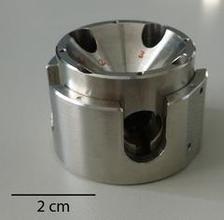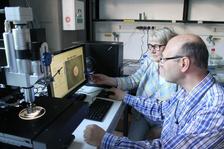A photo of the double-stage diamond cell developed at the University of Bayreuth. (Credit: University of Bayreuth)
An international team of scientists led by the University of Bayreuth and with participation of DESY has created the highest static pressure ever achieved in a lab: Using a special high pressure device, the researchers investigated the behaviour of the metal osmium at pressures of up to 770 Gigapascals (GPa) – more than twice the pressure in the inner core of the Earth, and about 130 Gigapascals higher than the previous world record set by members of the same team. Surprisingly, osmium does not change its crystal structure even at the highest pressures, but the core electrons of the atoms come so close to each other that they can interact – contrary to what is usually known in chemistry. This fundamental result published in the journal Nature has important implications for understanding physics and chemistry of highly compressed matter, for design of materials to be used at extreme conditions, and for modelling the interiors of giant planets and stars.
Metallic osmium (Os) is one of the most exceptional chemical elements, having at ambient pressure the highest known density of all elements, one of the highest cohesive energies, melting temperatures, and a very low compressibility – it is almost as incompressible as diamond. Due to its hardness, osmium finds applications in alloys used for instance as electrical contacts, wear-resistant machine parts and tips for high-quality ink pens.
“High pressure is known to radically affect properties of chemical elements: metals like sodium may become transparent insulators; gases like oxygen solidify and become electrical conductors – and even superconductors,” explains Natalia Dubrovinskaia from the University of Bayreuth, together with Leonid Dubrovinsky the main author of the study. “As any other material subjected to very high compression, osmium is expected to change its crystal structure.”
For their experiments, the scientists used a device for generating ultra-high static pressures developed by Dubrovinsky and Dubrovinskaia at Bayreuth. The device uses micro-anvils of only 10 to 20 micrometres (a micrometre is a thousandths of a millimetre) in diameter which are made of nanocrystalline diamond. These nanocrystals, which are diamond grains of a nano-size, are bound together forming a bulk micro-anvil. The many grain boundaries make the nanocrystalline anvils even harder than single crystal diamonds, extending the range of static pressure in experiments from about 400 GPa to 770 GPa at room temperature.
For probing the samples under these extreme conditions, the team used high-brilliance X-rays from the synchrotron sources PETRA III at DESY, ESRF in France and APS in the U.S. The team found that Osmium shows unprecedented structural stability and keeps its crystal structure even at huge pressures of about 770 GPa.
While the volume of the osmium unit cell steadily shrinks with rising pressure, very accurate X-ray diffraction experiments revealed anomalies in the behaviour of the lattice parameters describing the unit cell. Usually, changes in materials properties under pressure are associated with modifications in the configurations of the outer (valence) electrons. But in case of highly compressed osmium the reason for the observed structural anomaly is an interaction between the inner (core) electrons, as suggested by state-of-the-art theoretical calculations. “This work demonstrates that ultra-high static pressures can force the core electrons to interplay,” explains Dubrovinsky. “The ability to affect the core electrons even in such incompressible metals as osmium in static high-pressure experiments opens up exciting opportunities in searching for new states of matter.”
The experiments pave the way for investigating materials under conditions of the inner core of giant planets. “In the last 20 years, astronomers found more than thousand planets around other stars, nearly all of them bigger than our Earth,” says co-author Hanns-Peter Liermann from DESY, responsible for the beamline P02 at PETRA III, where some of the experiments took place. “With the newly developed double-stage diamond anvil cell and with the very focused high intensity X-ray spot at PETRA III – or later at the X-ray laser European XFEL that is currently being constructed in the Hamburg area – we can probe a variety of rocky planet compositions under most extreme conditions and will learn a lot about the composition and evolution of such planets.”
(from DESY Press Release)
Reference:
The most incompressible metal osmium at static pressures above 750 GPa;L. Dubrovinsky, N. Dubrovinskaia, E. Bykova, M. Bykov, V. Prakapenka, C. Prescher, K. Glazyrin, H.-P. Liermann, M. Hanfland, M. Ekholm, Q. Feng, L. V. Pourovskii, M. I. Katsnelson, J. M. Wills, and I. A. Abrikosov; Nature (2015); DOI: 10.1038/nature14681









